Numerical Simulation of Fluid-Structure Coupling for a Multi-Blade Vertical-Axis Wind Turbine
Abstract
:1. Introduction
2. Theoretical Background and Modeling Methods
3. Condition Setting
3.1. The Establishment of the Coupling Model
3.2. Coupled Meshing
3.2.1. Fluid Meshing
3.2.2. Solid Meshing
3.3. Mesh Quality Determination
3.4. Convergence Judgment
3.5. Definition of Physical Parameters
4. Results and Analysis
4.1. Structural Stress Analysis
4.2. Pressure Field Analysis
4.3. Deformation Analysis
5. Conclusions
- (1)
- For four kinds of wind turbines with different blade numbers, the maximum pressure in the overall structure all appears in the variable angle positions of the blades in the windward region under the same wind speed. This is primarily due to the rapid airflow changes, complex turbulence, and significant influence of the wind field on the blades at these positions, making them prone to bending or damage;
- (2)
- The equivalent pressure on the surface of four-blade and six-blade wind turbines is significantly higher than that of five-blade and three-blade wind turbines under the same external wind field environment. The equivalent pressure distribution curves at different measurement points on the three blades exhibit a gentle trend. The four-blade distribution curve shows minor fluctuations in localized areas but has an overall gentle trend. The pressure distribution curve of the five blades decreases slowly at first and then rises slowly with the increase of the measurement point value. The pressure distribution curve of the six blades has a drastic change, rapidly decreasing as the measurement points increase, reaching the lowest point, and then quickly rising;
- (3)
- The maximum deformation of the blades primarily occurs at the blade tips and edges. Additionally, among the four-wind turbine configurations with different blade numbers, the six-blade configuration has the highest maximum deformation, while the four-blade configuration has the lowest maximum deformation.
Author Contributions
Funding
Institutional Review Board Statement
Informed Consent Statement
Data Availability Statement
Acknowledgments
Conflicts of Interest
Nomenclature
| = | control volume | |
| = | control surface | |
| = | controlling the external normal direction of the control surface | |
| = | time | |
| = | viscosity | |
| = | pressure | |
| = | general scalar | |
| = | space size and shape change with time control volume | |
| = | boundary that controls the motion of the volume | |
| = | motion velocity of the moving grid | |
| = | velocity vector of the fluid | |
| = | dissipation coefficient | |
| = | source of the scalar | |
| = | (n + 1)th time step control volume | |
| = | number above the control volume | |
| = | jth area vector | |
| = | volume swept out by surface j on the control body in the time step | |
| = | mass matrix | |
| = | damping matrix | |
| = | stiffness matrix | |
| = | load exerted by the fluid on the blade |
References
- Wang, F.; Xu, X.Y. Prospect and problems of wind power market in China. Power Stat. Aux. Equip. 2010, 31, 1–4. [Google Scholar]
- Li, Y.; Yang, S.B.; Feng, F.; Kotar, T. A review on numerical simulation based on CFD technology of aerodynamic characteristics of straight-bladed vertical axis wind turbines. Energy Rep. 2023, 9, 4360–4379. [Google Scholar] [CrossRef]
- Ma, Y.H.; Zhang, Y.C.; Zhang, C.Y.; Guo, M.J.; Chen, J.Y.; Zhang, H.Y.; Liu, S.R. A review and consideration of wind energy utilization efficiency research. Environ. Technol. Innov. 2022, 12, 179–181. [Google Scholar]
- Lin, Y.X.; Zhang, J.Y. Development status and prospect of offshore wind power. Distrib. Energy 2023, 8, 1–10. [Google Scholar]
- Li, Z.; He, D. Reviews of fluid dynamics researches in wind energy engineering. Adv. Mech. 2013, 43, 472–525. [Google Scholar]
- Zhang, L.; Ye, T.; Xin, Y.; Han, F.; Fan, G. Problems and Measures of Power Grid Accommodating Large Scale Wind Power. Proc. CSEE 2010, 30, 1–9. [Google Scholar]
- Al-Ghriybah, M.; Zulkafli, M.F.; Didane, D.H.; Mohd, S. The effect of spacing between inner blades on the performance of the Savonius wind turbine. Sustain. Energy Tech. 2021, 43, 100988. [Google Scholar] [CrossRef]
- Zhang, Z.H.; Muhammad, A.; Liu, Q. New Theory and Method for Improving Utilization and Conversion Rate of Wind Turbine:Establishment of Blade Outlet Angle Formula and Its Application. J. Basic Microbiol. 2017, 25, 1040–1047. [Google Scholar]
- Yu, D.; Wang, K.Y.; Liu, H.X.; Ding, H.Q.; Kong, F.K.; Liu, W.Q. Numerical Simulation of Energy Capture Efficiency of a Vertical Axis Turbine Under Complex Sea Conditions. Mar. Technpl. Soc. J. 2021, 55, 17–28. [Google Scholar] [CrossRef]
- Wang, J.; Ren, P.L.; Wang, X.S. CFD study of a new type of vertical axis wind turbine. J. Eng. Thermophys. Rus. 2012, 33, 63–66. [Google Scholar]
- Yang, Y.F.; Pan, W.; Zhu, H.Q. An Overview and Recent Research Progresses of Vertical Axis Wind Turbine. China Mech. Eng. 2013, 24, 703–709. [Google Scholar]
- Ai, C.; Zhang, Y.B.; Jia, C.D.; Zhang, L.; Kong, X.D. Research on rotating speed control of the vertical axis hydraulic wind turbine. T Can. Soc. Mech. Eng. 2020, 44, 567–579. [Google Scholar] [CrossRef]
- Boztas, A.; Demirbas, O.; Sahin, M. Investigation of vertical axis wind turbines and their components design. Turk. J. Electromec. Energy 2021, 6, 64–72. [Google Scholar]
- Ma, L.J.; Chen, J.; Du, G.; Cao, R.J. Numerical simulation of aerodynammic performance for wind turbine airfoils. Acta Energ. Sol. Sin. 2010, 31, 203–209. [Google Scholar]
- Kirke, B. Evaluation of Self-Starting Vertical Axis Wind Turbines for Stand-Alone Applications. Doctoral Dissertation, Griffith University, Gold Coast, QLD, Australia, 1998. [Google Scholar]
- Hoogedoom, E.; Jacobs, G.B.; Beyene, A. Aero-elastic behavior of a flexible blade for wind turbine application: A 2D computational study. Energy 2010, 35, 778–785. [Google Scholar] [CrossRef]
- MacPhee, D.W.; Beyene, A. Fluid–structure interaction analysis of a morphing vertical axis wind turbine—ScienceDirect. J. Fluid. Struct. 2016, 60, 143–159. [Google Scholar] [CrossRef]
- Hsu, M.C.; Bazilevs, Y. Fluid-structure interaction modeling of wind turbines: Simulating the full machine. Comput. Mech. 2012, 50, 821–833. [Google Scholar] [CrossRef]
- Han, Z. Fluid-Solid Coupling Analysis of Blades of Small Vertical Axis Wind Turbines. Master’s Thesis, Inner Mongolia University of Technology, Hohhot, China, 2021. [Google Scholar]
- Wei, K.P. Research on Unsteady Fluid Solid Coupling Numerical Simulation Method of H-Type Vertical Axis Wind Turbine. Master’s Thesis, Guangdong University of Technology, Guangdong, China, 2020. [Google Scholar]
- Feng, F.; Li, Y.; Chen, L.X.; Tian, W.Q.; Zhang, Y.W. A simulation and experimental researach on aerodynamic characteristics of combined type vertical axis wind turbine. Acta Energiae Solaris Sin. 2014, 35, 855–860. [Google Scholar]
- Ageze, M.B.; Hu, Y.F.; Wu, H.C. Comparative Study on Uni- and Bi-Directional Fluid Structure Coupling of Wind Turbine Blades. Energies 2017, 10, 1449. [Google Scholar] [CrossRef] [Green Version]
- Liao, M.F.; Li, Y.; Wang, Q.Y.; Lu, P. Study on Fluid-structure Interaction Characteristic for Large Scaled Wind Turbine Blade. Mech. Sci. Technol. Aerosp. Eng. 2018, 37, 493–500. [Google Scholar]
- Zhang, Z.Y.; Wang, T.G.; Chen, L.; Xu, B.F.; Luo, Y. Aerodynamic design and numerical optimization for conceptual wind turbine blades with multiple winglets. Acta Aerodyn. Sin. 2013, 31, 127–131. [Google Scholar]
- Zheng, J.H.; Cui, D.; Jiang, P.X. Static analysis of MW wind turbine nacelle chassis. Mach. Des. Manuf. 2010, 11, 197–198. [Google Scholar]
- Marsh, G. Wind turbines: How big can they get? Refocus 2005, 6, 22–28. [Google Scholar] [CrossRef]
- Yang, C.X.; Li, S.F. Study of post-stalled airfoil of a H-type vertical axis wind turbine. J. Lanzhou Univ. Technol. 2015, 41, 51–54. [Google Scholar]
- Duque, E.; Burkland, M.; Johnson, W. Navier-Stokes and Comprehensive Analysis Performance Predictions of the NREL Phase VI Experiment. J. Sol. Energy Eng. 2003, 125, 43–61. [Google Scholar] [CrossRef]
- Versteeg, H.K.; Malalasekera, W. An Introduction to Computational Fluid Dynamics: The Finite Volume Method; World Book Inc.: London, UK, 2010. [Google Scholar]
- Yang, S.M.; Tao, W.S. Heat Transfer Theory, 4th ed.; Beijing Higher Education Press: Beijing, China, 2006. [Google Scholar]
- Hirsch, C. Numerical Computation of Internal and External Flows. Int. J. Heat Fluid F. 2007, 10, 371. [Google Scholar]
- Mirzaei, M.; Ardekani, M.A.; Doosttalab, M. Numerical and experimental study of flow field characteristics of an iced airfoil. Aerosp. Sci. Technol. 2009, 13, 267–276. [Google Scholar] [CrossRef]
- Tang, J.P. Ansys Fluent 16.0 Super Learning Manual; People’s Post and Telecommunications Publishing House: Beijing, China, 2016. [Google Scholar]
- Fu, P.; Farzaneh, M. A CFD approach for modeling the rime-ice accretion process on a horizontal-axis wind turbine. J. Wind Eng. Ind. Aerod. 2010, 98, 181–188. [Google Scholar] [CrossRef]
- Kong, C.; Bang, J.; Sugiyama, Y. Structural investigation of composite wind turbine blade considering various load cases and fatigue life. Energy 2005, 30, 2101–2114. [Google Scholar] [CrossRef]
- Yang, J.; Wu, M.P.; Ye, J.Y.; Wang, Y. Aerodynamic Design and Strutural Studies of Wind Turbine Blades. Machinery 2014, 52, 5–8. [Google Scholar]
- Liu, P.F.; Liu, J.W.; Wang, C.Z. Finite element analysis of damage mechanisms of composite wind turbine blade by considering fluid/solid interaction. Part II: T-shape adhesive structure. Compos. Struct. 2022, 301, 116212. [Google Scholar] [CrossRef]
- Gao, Y.D.; Hu, X.; Duo, C. Concrete Truck Mixer Blade Fatigue Analysis Based on the Fluid-Structure Interaction. Mach. Des. Manuf. 2015, 291, 47–49. [Google Scholar]
- Ding, Y.; Wu, J.H. ANSYS CFX14.0 from Beginner to Master; Beijing Tsinghua University Press: Beijing, China, 2013. [Google Scholar]
- Cao, W.B.; Li, H.X.; Gao, H.H. Convergence analysis and application of the slip boundary conditions. J. Natl. Def. Univ. Sci. Technol. 2013, 35, 12–18. [Google Scholar]
- Chong, X. Assessment of second-order velocity-slip boundary conditions of the navier-stokes equations. J. Sol. Energy Eng. 2007, 39, 1–6. [Google Scholar]
- Lv, C. Study of Dynamic Grid Deformationical Algorithm and Its Application. Master’s Thesis, National University of Defense Technology, Changsha, China, 2010. [Google Scholar]

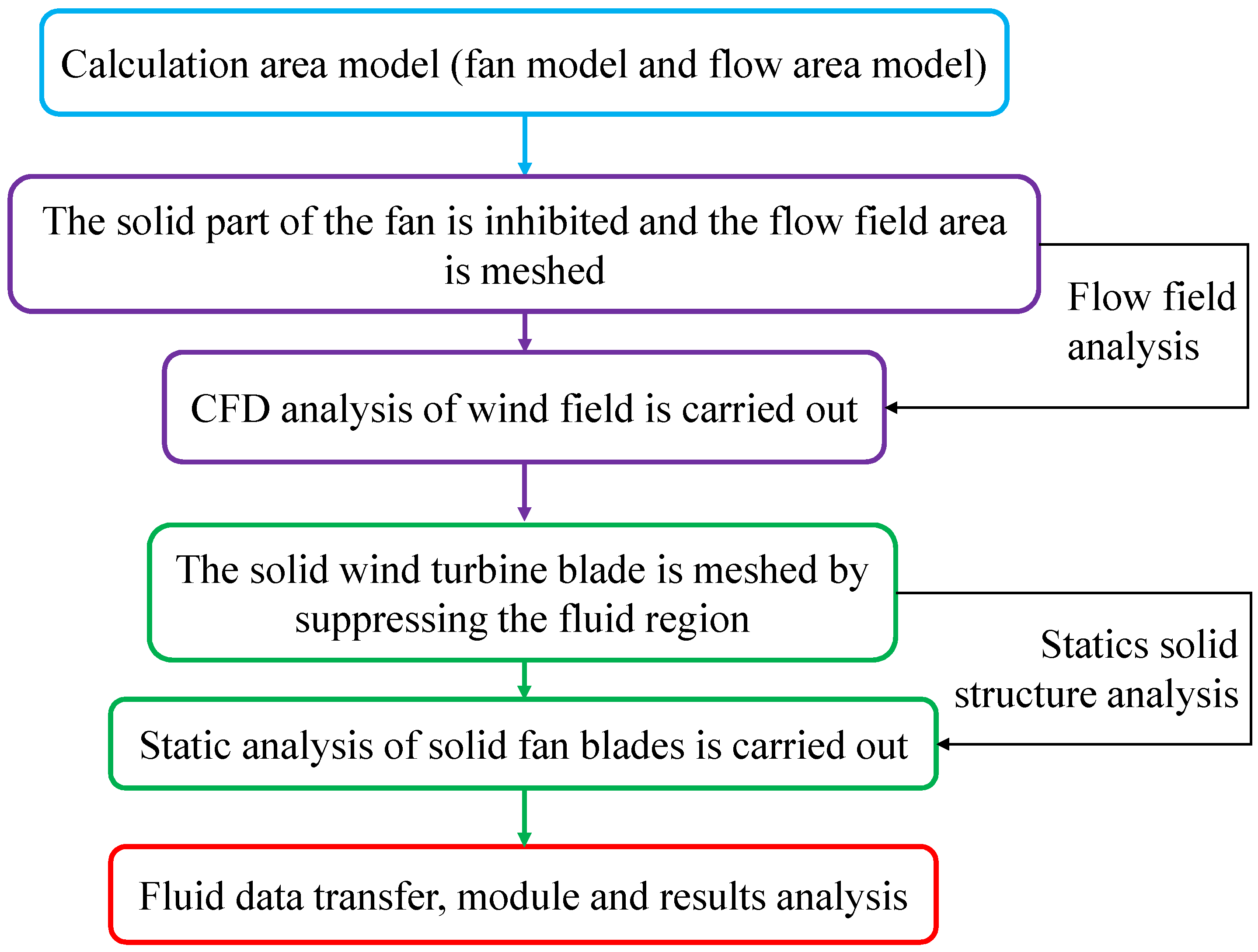
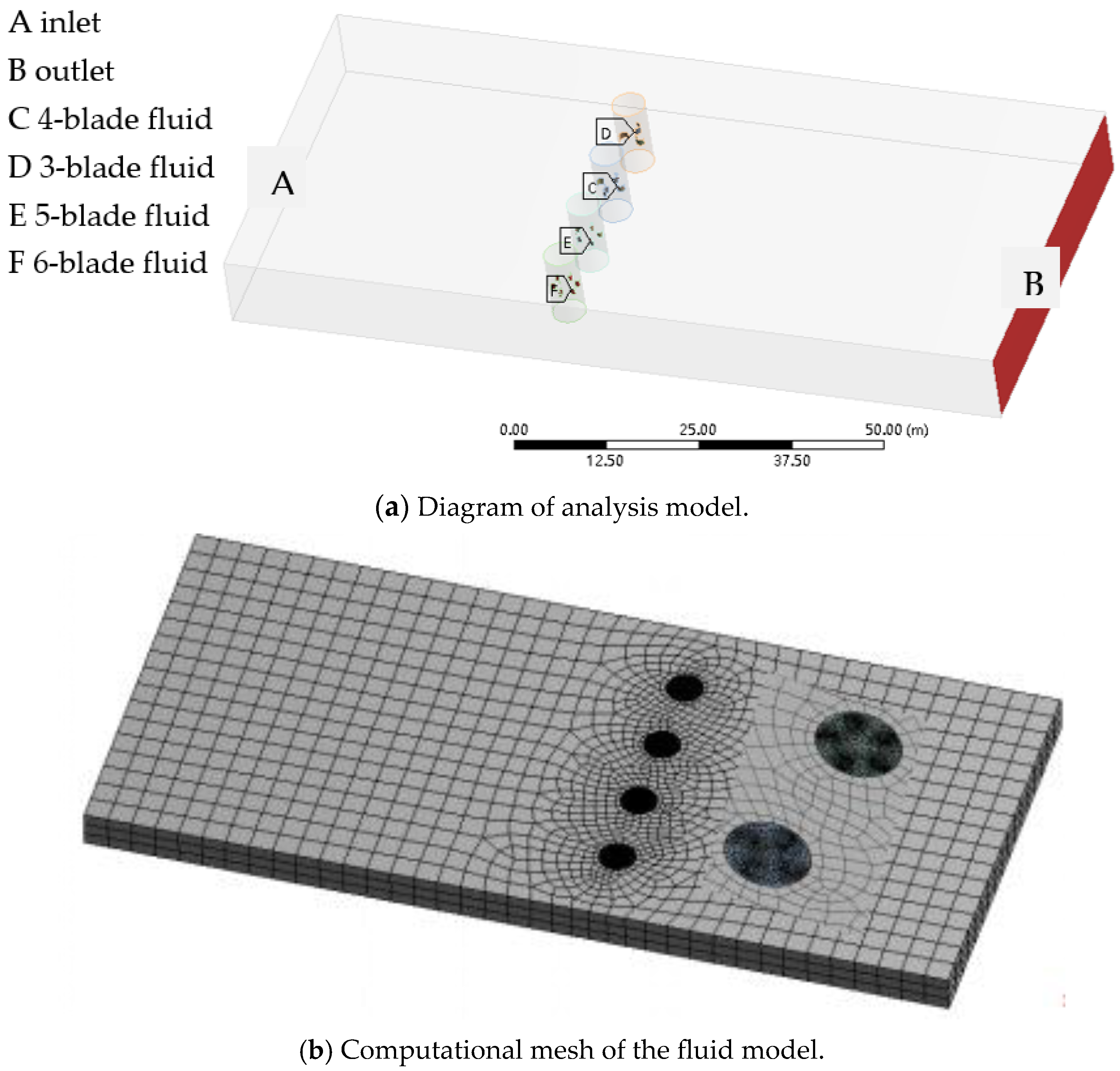



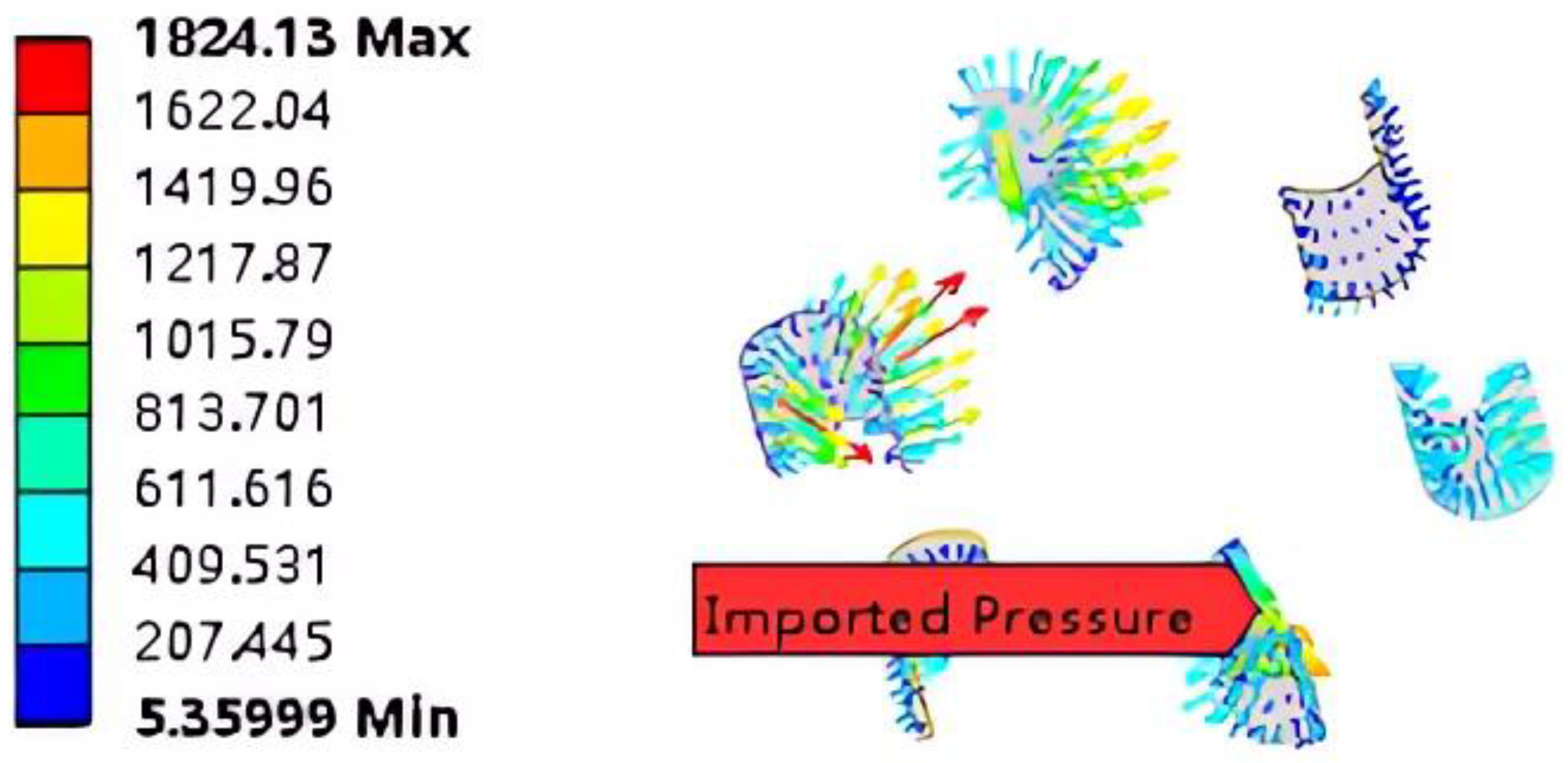
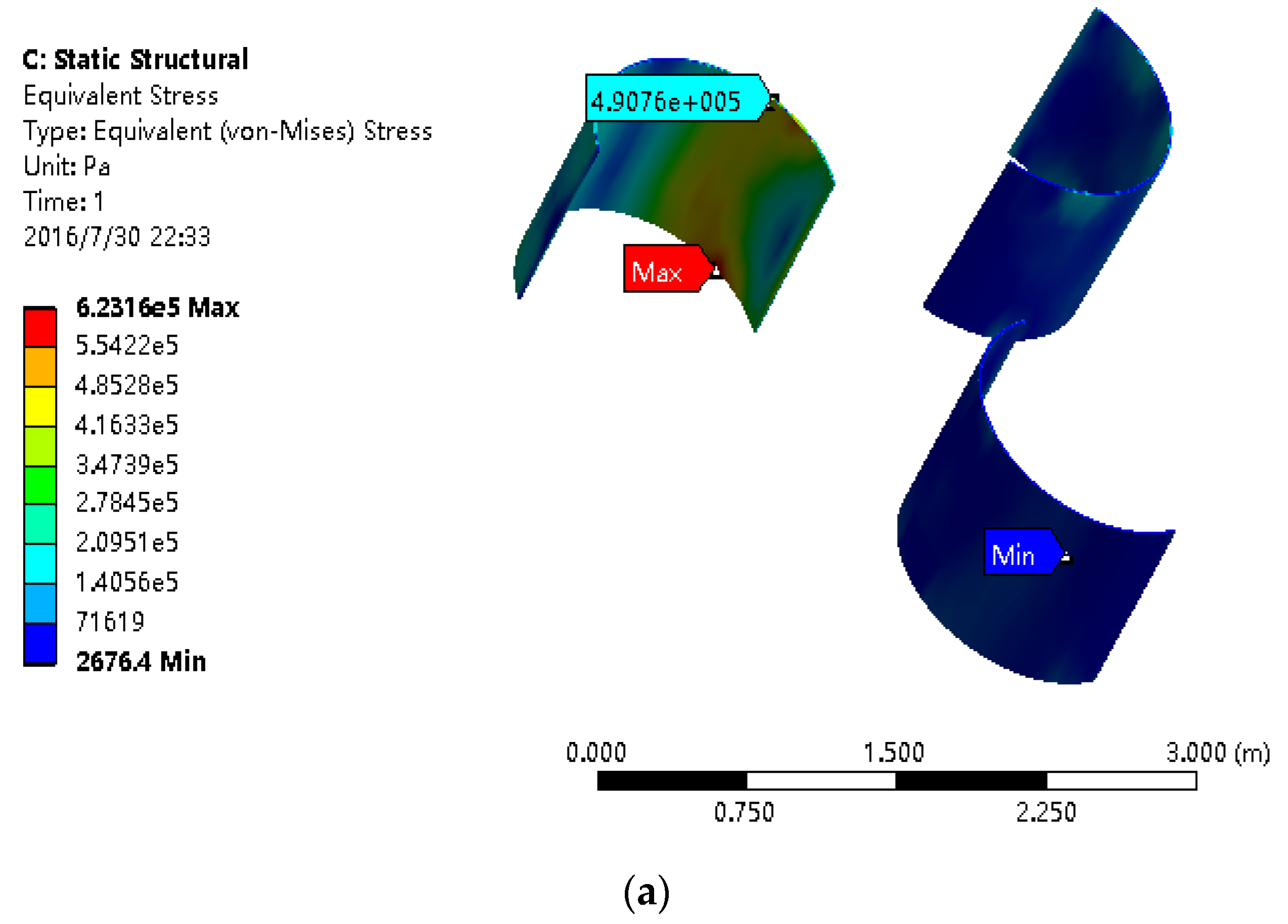
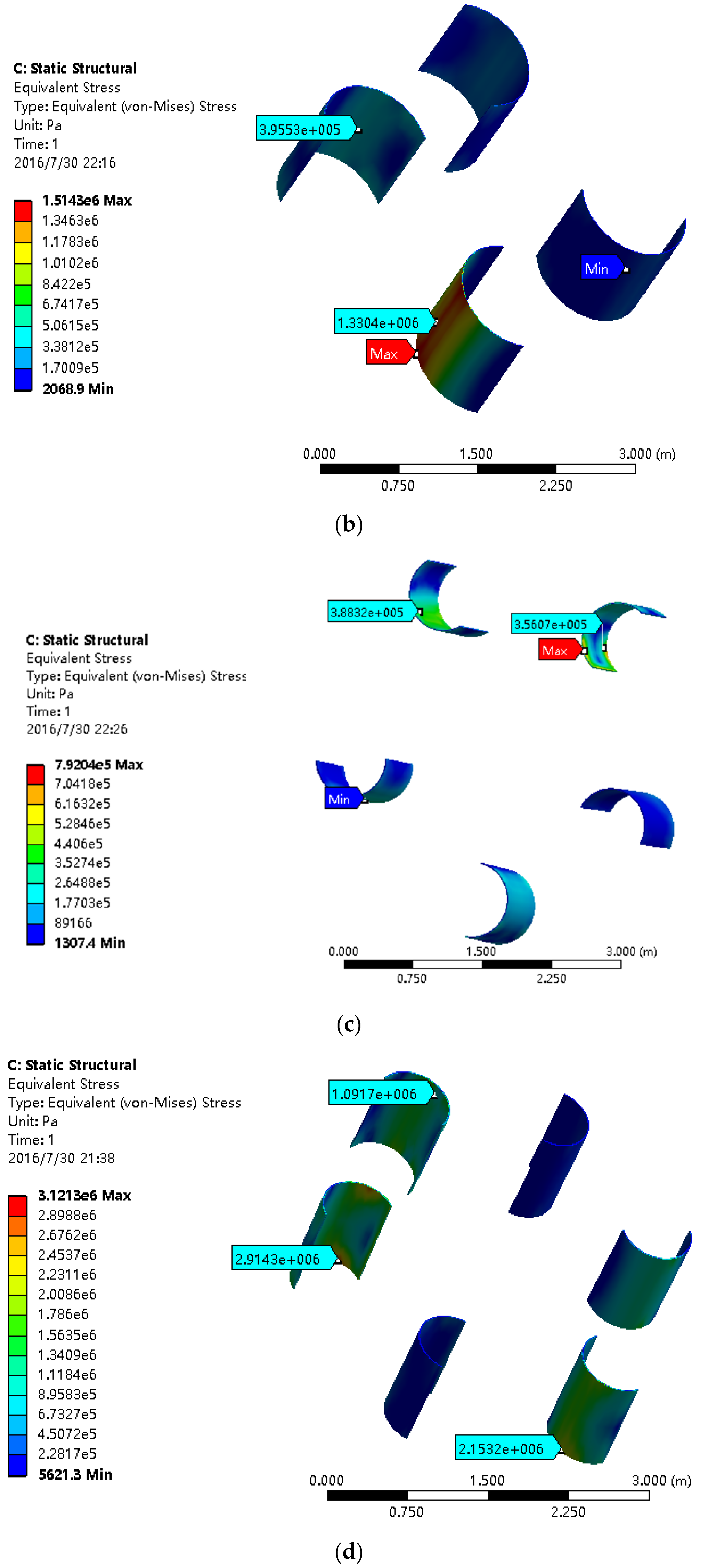


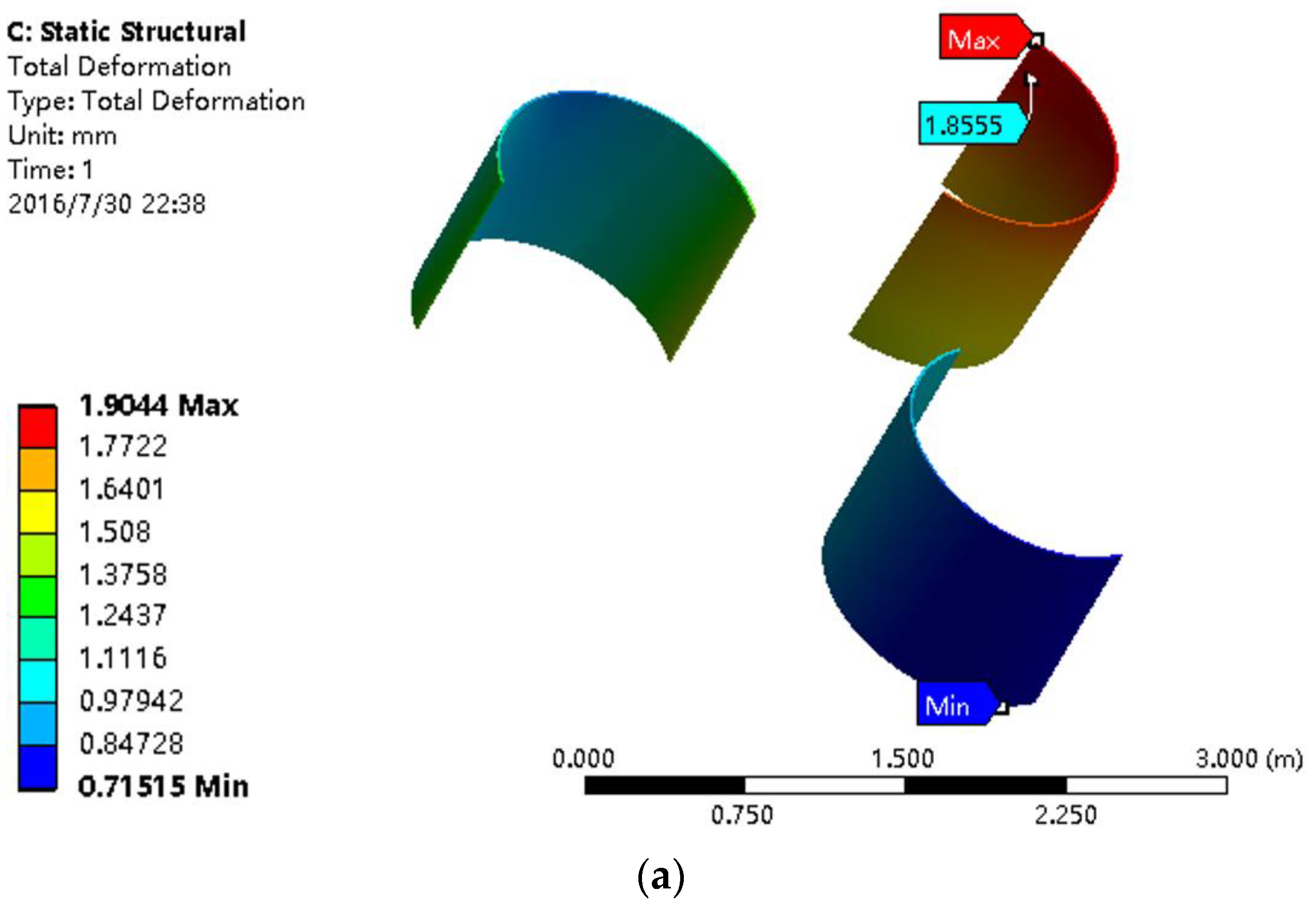

| Poisson’s Ratio | Young’s Modulus | Density | Yield Strength |
|---|---|---|---|
| 0.25 | 206 GPa | 7850 kg/m3 | 2.5 × 108 Pa |
| Fan Type | Point 1 | Point 2 | Point 3 | Point 4 | Point 5 | Point 6 | Point 7 | Point 8 |
|---|---|---|---|---|---|---|---|---|
| three-blade | 6.23 × 105 | 5.76 × 105 | 4.75 × 105 | 4.02 × 105 | 3.62 × 105 | 3.58 × 105 | 4.90 × 105 | 5.01 × 105 |
| four-blade | 1.33 × 106 | 1.38 × 106 | 1.41 × 106 | 1.42 × 106 | 1.41 × 106 | 1.43 × 106 | 1.38 × 106 | 1.37 × 106 |
| five-blade | 7.92 × 105 | 6.61 × 105 | 4.22 × 105 | 2.41 × 105 | 1.61 × 105 | 1.34 × 105 | 1.68 × 105 | 3.93 × 105 |
| six-blade | 2.49 × 106 | 1.80 × 106 | 1.38 × 106 | 1.05 × 106 | 1.15 × 106 | 1.34 × 106 | 1.74 × 106 | 2.63 × 106 |
Disclaimer/Publisher’s Note: The statements, opinions and data contained in all publications are solely those of the individual author(s) and contributor(s) and not of MDPI and/or the editor(s). MDPI and/or the editor(s) disclaim responsibility for any injury to people or property resulting from any ideas, methods, instructions or products referred to in the content. |
© 2023 by the authors. Licensee MDPI, Basel, Switzerland. This article is an open access article distributed under the terms and conditions of the Creative Commons Attribution (CC BY) license (https://creativecommons.org/licenses/by/4.0/).
Share and Cite
Zhang, X.; Zheng, M. Numerical Simulation of Fluid-Structure Coupling for a Multi-Blade Vertical-Axis Wind Turbine. Appl. Sci. 2023, 13, 8612. https://doi.org/10.3390/app13158612
Zhang X, Zheng M. Numerical Simulation of Fluid-Structure Coupling for a Multi-Blade Vertical-Axis Wind Turbine. Applied Sciences. 2023; 13(15):8612. https://doi.org/10.3390/app13158612
Chicago/Turabian StyleZhang, Xiao, and Maosheng Zheng. 2023. "Numerical Simulation of Fluid-Structure Coupling for a Multi-Blade Vertical-Axis Wind Turbine" Applied Sciences 13, no. 15: 8612. https://doi.org/10.3390/app13158612




